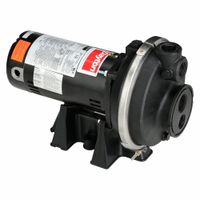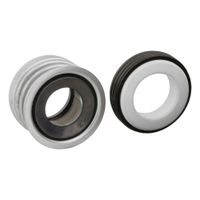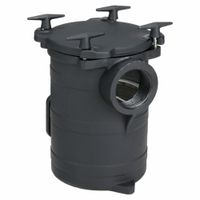Call +(254) 703 030 000 / 751 483 999 / 721 704 777
- Home
- Furnishings Appliances Hospitality
- Fitness Sports Recreation
- Pool Spa Equipment
- Pool Spa Pumps Strainers
.....Read More
Frequently Asked Questions
What size pump do I need for my pool or spa?
To determine the appropriate pump size for your pool or spa, consider the following factors:
1. **Pool Volume**: Calculate the total volume of your pool or spa in gallons. For rectangular pools, use the formula: Length x Width x Average Depth x 7.5. For circular pools, use: Diameter x Diameter x Average Depth x 5.9.
2. **Turnover Rate**: Pools typically require a turnover rate of 8-10 hours, meaning the pump should circulate all the water within this time. For spas, a turnover rate of 30 minutes to 1 hour is common.
3. **Flow Rate**: Determine the required flow rate in gallons per minute (GPM) by dividing the total volume by the turnover rate (in minutes). For example, a 20,000-gallon pool with an 8-hour turnover rate needs a flow rate of about 42 GPM (20,000 / 480 minutes).
4. **Total Dynamic Head (TDH)**: Calculate the TDH, which includes the resistance from pipes, fittings, and equipment. This is measured in feet and can be estimated using online calculators or by consulting a professional.
5. **Pump Performance Curve**: Match the required flow rate and TDH to a pump's performance curve to find a suitable model. Ensure the pump can handle the calculated GPM at the given TDH.
6. **Energy Efficiency**: Consider variable-speed pumps for energy savings, as they adjust the flow rate to meet different needs, reducing energy consumption.
7. **Local Regulations**: Check local codes and regulations, as some areas have specific requirements for pool and spa pumps.
By considering these factors, you can select a pump that efficiently circulates water, maintains water quality, and operates cost-effectively.
How often should I clean the strainer basket in my pool or spa pump?
You should clean the strainer basket in your pool or spa pump at least once a week. Regular maintenance is crucial to ensure optimal water flow and prevent the pump from overworking. If your pool or spa is surrounded by trees or experiences heavy usage, you may need to clean it more frequently, possibly two to three times a week. During periods of heavy debris, such as after a storm or during the fall when leaves are abundant, check the basket more often.
To clean the strainer basket, first, turn off the pump to prevent any accidents. Close the valves on both the suction and return lines to avoid water flow. Open the pump lid and remove the basket. Clear out any debris, such as leaves, hair, or dirt, and rinse the basket with a hose to ensure all small particles are removed. Inspect the basket for any cracks or damage, as a compromised basket can allow debris to enter the pump, potentially causing damage. Once cleaned, replace the basket, ensuring it is seated correctly, and secure the pump lid tightly to prevent air leaks. Reopen the valves and turn the pump back on, checking for proper operation.
Regular cleaning of the strainer basket not only extends the life of your pump but also improves the efficiency of your pool or spa's filtration system, ensuring clean and clear water.
What is the best way to maintain my pool or spa pump?
1. **Regular Inspection**: Check for leaks, unusual noises, or vibrations. Ensure the pump is securely mounted.
2. **Clean the Pump Basket**: Regularly remove debris from the pump basket to maintain water flow and prevent clogging.
3. **Monitor Water Levels**: Ensure water levels are adequate to prevent the pump from running dry, which can cause damage.
4. **Check and Clean Filters**: Clean or replace filters as needed to maintain efficient water circulation and filtration.
5. **Lubricate O-rings**: Apply a silicone-based lubricant to O-rings to prevent drying and cracking, ensuring a proper seal.
6. **Inspect Electrical Connections**: Ensure all electrical connections are secure and free from corrosion.
7. **Maintain Proper Water Chemistry**: Balance pH, alkalinity, and sanitizer levels to prevent corrosion and scale buildup in the pump.
8. **Winterize if Necessary**: In colder climates, properly winterize the pump to prevent freeze damage.
9. **Schedule Professional Maintenance**: Have a professional inspect and service the pump annually to ensure optimal performance.
10. **Keep the Area Clean**: Remove leaves, dirt, and debris around the pump to prevent them from entering the system.
11. **Monitor Pump Performance**: Keep an eye on the pressure gauge and flow rate to detect any issues early.
12. **Use a Timer**: Set a timer to run the pump during off-peak hours to save energy and ensure consistent operation.
13. **Avoid Overworking the Pump**: Run the pump for the recommended duration based on pool size and usage to prevent wear and tear.
14. **Replace Worn Parts**: Promptly replace any worn or damaged parts to prevent further damage to the pump.
How do I know if my pool or spa pump is working efficiently?
1. **Flow Rate**: Check the flow rate of your pump. It should match the specifications provided by the manufacturer. A significant drop in flow rate can indicate inefficiency.
2. **Energy Consumption**: Monitor the energy consumption of your pump. Compare it with the expected usage for your pump model. Higher than normal energy usage can signal inefficiency.
3. **Noise Levels**: Listen for unusual noises. A well-functioning pump should operate quietly. Loud or strange noises can indicate mechanical issues affecting efficiency.
4. **Water Clarity**: Observe the clarity of your pool or spa water. Cloudy water can suggest that the pump is not circulating water effectively.
5. **Pressure Gauge**: Check the pressure gauge on your filter system. A higher than normal reading can indicate a blockage or that the pump is working harder than necessary.
6. **Pump Basket and Filter**: Regularly inspect and clean the pump basket and filter. Clogs can reduce efficiency by restricting water flow.
7. **Pump Run Time**: Ensure the pump is running for the appropriate amount of time each day. Over or under-running can affect efficiency and water quality.
8. **Variable Speed Settings**: If you have a variable speed pump, ensure it is set to the optimal speed for your pool or spa size. Incorrect settings can lead to inefficiency.
9. **Maintenance History**: Regular maintenance is crucial. Check the maintenance history to ensure the pump has been serviced as recommended.
10. **Professional Inspection**: Consider having a professional inspect your pump. They can identify issues that may not be apparent to the untrained eye.
By regularly monitoring these factors, you can ensure your pool or spa pump is working efficiently.
How can I prevent my pool or spa pump from overheating?
1. **Proper Ventilation**: Ensure the pump is installed in a well-ventilated area to allow heat to dissipate. Avoid enclosing the pump in a small, confined space.
2. **Regular Maintenance**: Clean the pump basket and skimmer regularly to prevent clogs that can cause the pump to work harder and overheat.
3. **Check Water Flow**: Ensure there is adequate water flow to the pump. Blockages in the suction line or a closed valve can cause the pump to overheat.
4. **Correct Sizing**: Use a pump that is appropriately sized for your pool or spa. An oversized pump can generate excess heat, while an undersized pump can overwork itself.
5. **Inspect for Leaks**: Regularly check for leaks in the pump and plumbing. Leaks can lead to air entering the system, causing the pump to lose prime and overheat.
6. **Monitor Electrical Connections**: Ensure all electrical connections are secure and in good condition. Faulty wiring can lead to overheating.
7. **Use a Timer**: Install a timer to prevent the pump from running longer than necessary, reducing the risk of overheating.
8. **Install a Thermal Overload Protector**: Many pumps come with built-in thermal overload protectors that automatically shut off the pump if it gets too hot. Ensure this feature is functional.
9. **Shade the Pump**: If the pump is exposed to direct sunlight, consider shading it to reduce heat exposure.
10. **Regular Inspections**: Have a professional inspect the pump periodically to ensure it is operating efficiently and to catch potential issues early.
What are the signs that my pool or spa pump needs to be replaced?
1. **Unusual Noises**: Grinding, screeching, or rattling sounds may indicate worn-out bearings or internal damage.
2. **Reduced Water Flow**: A noticeable decrease in water circulation can suggest a failing pump or clogged impeller.
3. **Frequent Tripping**: If the pump frequently trips the circuit breaker, it may be overheating or have electrical issues.
4. **Leaks**: Water or oil leaks around the pump housing or seals can indicate worn-out components.
5. **Age**: Pumps older than 8-10 years may be less efficient and more prone to failure.
6. **Increased Energy Bills**: A sudden rise in energy costs can signal that the pump is working harder than necessary.
7. **Overheating**: If the pump is hot to the touch, it may be struggling to operate efficiently.
8. **Air in the System**: Bubbles or air in the water return lines can indicate a suction leak or pump issue.
9. **Frequent Repairs**: Constant need for repairs can be a sign that replacement is more cost-effective.
10. **Corrosion or Rust**: Visible rust or corrosion on the pump can compromise its functionality.
11. **Vibrations**: Excessive vibrations can indicate misalignment or internal damage.
12. **Motor Issues**: If the motor doesn’t start or runs intermittently, it may be failing.
13. **Burnt Smell**: A burnt odor can indicate electrical problems or overheating.
14. **Poor Performance**: Inability to maintain proper pool or spa cleanliness and chemical balance.
15. **Visual Wear and Tear**: Cracks or damage to the pump housing or components.
How do I choose the right strainer for my pool or spa pump?
1. **Pump Compatibility**: Ensure the strainer is compatible with your specific pump model. Check the manufacturer's specifications for recommended strainer types.
2. **Material**: Choose a strainer made from durable materials like high-grade plastic or stainless steel to withstand pool chemicals and environmental conditions.
3. **Size and Capacity**: Select a strainer with the appropriate size and capacity to handle the water flow rate of your pool or spa. Larger pools require strainers with higher capacity.
4. **Mesh Size**: Consider the mesh size of the strainer basket. Finer mesh captures smaller debris but may require more frequent cleaning.
5. **Ease of Maintenance**: Opt for a strainer that is easy to access and clean. Look for features like a clear lid for visibility and a quick-release mechanism.
6. **Seal Quality**: Ensure the strainer has a high-quality seal to prevent leaks and maintain efficient suction.
7. **Brand and Reviews**: Choose reputable brands known for quality and reliability. Check customer reviews for performance insights.
8. **Cost**: Balance cost with quality. While cheaper options may save money upfront, investing in a durable, efficient strainer can reduce long-term maintenance costs.
9. **Warranty**: Consider products with a good warranty for added assurance and support.
10. **Professional Advice**: Consult with a pool professional or technician for personalized recommendations based on your specific pool or spa setup.


